Similar presentations:
Dental caries prevention
1.
Prof. Nagwa KhattabProfessor of Pediatric and Community Dentistry
sinaiuniversity.net
2. Caries Prevention
Professor Nagwa Khattab@Sinaiunieg
info@su.edu.eg
www.su.edu.eg
3.
Improve host resistantHost
Bacteria
Diet
Professor Nagwa Khattab
@Sinaiunieg
info@su.edu.eg
www.su.edu.eg
4.
Modifying caries promoting ingredients of the diet:o Reduction of carbohydrate
o Sucrose substitutes
o Additives for caries prevention
Combating caries inducing microorganisms:
o Mechanical
o Chemical
o Immunological
Increasing the resistance of the tooth to caries:
o Fluoride
o Fissure sealant
o Laser light
o Remineralizing solutions
Professor Nagwa Khattab
@Sinaiunieg
info@su.edu.eg
www.su.edu.eg
5. Caries prevention
byIncreasing the tooth
resistance
Professor Nagwa Khattab
@Sinaiunieg
info@su.edu.eg
www.su.edu.eg
6. Increasing The Tooth Resistance
Fissuresealant
Increasing The Tooth Resistance
Professor Nagwa Khattab
@Sinaiunieg
info@su.edu.eg
www.su.edu.eg
7. FLUORIDE
Professor Nagwa Khattab@Sinaiunieg
info@su.edu.eg
www.su.edu.eg
8. What is fluoride?
F-Professor Nagwa Khattab
@Sinaiunieg
info@su.edu.eg
www.su.edu.eg
9.
Sources of fluorideProfessor Nagwa Khattab
@Sinaiunieg
info@su.edu.eg
www.su.edu.eg
10. Sources of fluoride
o
o
o
o
Soil: Rocks, soil, and volcanic rocks
Water:
Sea water (1.2-1.4 mg/kg)
Rivers ( Nile river: 0.37-0.42mg/kg)
Oceans (1mg/kg)
Deep wells
• Air: Air of the non-industrial areas contains 0.05 to 1.9
mg/m3.
Air in industrial areas have higher level of fluoride 18-19
mg/m3 (production of aluminum, phosphate fertilizers
,plastics & heavy metals)
Professor Nagwa Khattab
@Sinaiunieg
info@su.edu.eg
www.su.edu.eg
11.
Food:o Meat and poultry contain little fluoride
o Sea foods may contain 2.5ppm
o Most of beverages & tea.
o Banana &Potatoes
Drugs and general anesthetics:
o Diuretics (Benzothiadines)
o Tranquilizers (Phenothiazines)
oAnesthetic agents ( Halothane ,Enflurane)
Professor Nagwa Khattab
@Sinaiunieg
info@su.edu.eg
www.su.edu.eg
12.
MetabolismProfessor Nagwa Khattab
@Sinaiunieg
info@su.edu.eg
www.su.edu.eg
13. Metabolism
• Absorption85%
GIT
lungs
• Distribution
•B
95%
•T
2,200-3,200 ppm
4,500
100-650
Professor Nagwa Khattab
@Sinaiunieg
info@su.edu.eg
www.su.edu.eg
14.
Sk
h
maximum
•B
l
a
the least
Fluoride in the plasma : 0.4- 0.9 mg/L
Professor Nagwa Khattab
@Sinaiunieg
info@su.edu.eg
www.su.edu.eg
15. Excretion of fluoride:
• Kidney: 30% within 3 hrs and 40-60% within 24 hrs• Gut :10% is excreted in feces
• Sweat 10-25%
• Traces: in saliva , milk , tears and hair.
Professor Nagwa Khattab
@Sinaiunieg
info@su.edu.eg
www.su.edu.eg
16.
Fluoride and dentalhealth
Professor Nagwa Khattab
@Sinaiunieg
info@su.edu.eg
www.su.edu.eg
17. Uptake of fluoride by the teeth
• Before eruption:During calcification and further amounts of
fluoride are taken up from the surrounding tissue
fluids before eruption.
• After eruption:
After tooth eruption, during enamel maturation?
There is continued accumulation of fluoride in
enamel from saliva, fluoride containing water and
food
Professor Nagwa Khattab
@Sinaiunieg
info@su.edu.eg
www.su.edu.eg
18. Fluoride and dental health
• Affinity between fluoride ions and hydroxyapetite of teethand bone.
• Inverse relationship between fluoride and carbonate
concentrations in enamel
• Fluoride is an important anticariogenic agent
• It inhibits demineralization and enhances remineralization
process
Professor Nagwa Khattab
@Sinaiunieg
info@su.edu.eg
www.su.edu.eg
19. Mode of action of fluoride
1.Ionic exchange.
2.
Bacterial inhibition
3.
Enzymatic inhibition (inhibits glycolysis)
4.
Aids in remineralization of demineralized enamel.
5.
Fluoride lowers the enamel surface energy.
6.
Effect of fluoride on tooth morphology.
Professor Nagwa Khattab
@Sinaiunieg
info@su.edu.eg
www.su.edu.eg
20.
HydroxyapititeTooth
morphology
Mode of
action of
fluoride
Enamel
surface
Bacteria of dental plaque
Professor Nagwa Khattab
@Sinaiunieg
info@su.edu.eg
www.su.edu.eg
21. Mode of action of fluoride
• Action on hydroxyapitite• Action on bacteria of dental plaque
• Action on enamel surface
• Alteration of the tooth morphology
Professor Nagwa Khattab
@Sinaiunieg
info@su.edu.eg
www.su.edu.eg
22.
Methods of ProvidingFluoride
Professor Nagwa Khattab
@Sinaiunieg
info@su.edu.eg
www.su.edu.eg
23.
Methods ofProviding
Fluoride
Systemic
Administration
Topical
Application
Professor Nagwa Khattab
@Sinaiunieg
info@su.edu.eg
www.su.edu.eg
24. Systemic Fluoride Administration
Professor Nagwa Khattab@Sinaiunieg
info@su.edu.eg
www.su.edu.eg
25. Fluoridation of water supply
• Definition:The adjustment of the natural fluoride concentration of fluoride
deficient water supplies to the recommended level for optimal
dental health.
Water fluoridation is the process of adding fluoride to the water
supply so that the level reaches 1 ppm (one part F per million
parts water)
One mg F/L water
Professor Nagwa Khattab
@Sinaiunieg
info@su.edu.eg
www.su.edu.eg
26. Fluoridation of water supply
• Fluoridation of the public water supply at 1 ppm has beenshown in to reduce caries incidence by around 50%.
Water fluoridation is an ideal public health measure?
oIts benefits are not dependent on the interest and
cooperation of the recipients.
o It is cheap .
o Reaches many peoples
Professor Nagwa Khattab
@Sinaiunieg
info@su.edu.eg
www.su.edu.eg
27. Fluoridation of water supply
• The optimal dose of fluoride ingested daily in childrenfrom 0.5 to 1.0 gm fluoride (WHO).
• Fluoride concentration in public water supplies for
countries with cold weather (1-1.2 ppm) , whereas in
countries with hot weather the concentration of
fluoride should be lower (0.7).
• In Egypt the fluoride concentration of Nile water is
about 0.36-0.42 ppm
Professor Nagwa Khattab
@Sinaiunieg
info@su.edu.eg
www.su.edu.eg
28.
The recommended optimal fluoride doses0.7 to 1.2 ppm
?
In Egypt the fluoride concentration of Nile
water is about 0.36 - 0.42 ppm
??
Is it optimal
Professor Nagwa Khattab
@Sinaiunieg
info@su.edu.eg
www.su.edu.eg
29. Fluoridation of School water supplies
• Fluoridation of school water supply is the bestapproach if fluoridation of community water
supplies is not possible
• A higher fluoride concentration up to 5 ppm have
been effective in caries control in School children.
• The reduction in the DMFS is about 40%.
Professor Nagwa Khattab
@Sinaiunieg
info@su.edu.eg
www.su.edu.eg
30. Fluoride supplements
• Supplements can be in the form of tablets,drops or syrups.
• The usual dose varies according child age
& conc. of F in communal water supply.
F
• Fluoride administration should be
continued till the age of complete crown
formation of the second permanent molar.
Professor Nagwa Khattab
@Sinaiunieg
info@su.edu.eg
www.su.edu.eg
31. Fluoride Supplement Dosage Schedule,1994 Approved by the A. D. A , A .A.P and A.A.P.D
A. D. A A .A.PAge
A.A.P.D
Fluoride Ion Level in Drinking Water (ppm)*
< 0.3 ppm
0.3-0.6 ppm
> 0.6 ppm
Birth-6 months
None
None
None
6 months-3 years
0.25 mg/day
None
None
3-6 years
0.50 mg/day
0.25 mg/day
None
6-14 years
1.0 mg/day
0.50 mg/day
None
* 1.0 ppm = 1 mg/liter
** 2.2 mg sodium fluoride contains 1 mg fluoride ion.
Professor Nagwa Khattab
@Sinaiunieg
info@su.edu.eg
www.su.edu.eg
32. Fluoride incorporation in various foods
Fluoride incorporated in certain foods ofcommon use such as salt, milk, bread, rice.
Personal choice
Therefore, it is difficult to adjust fluoride concentration
as the consumption of these foods may vary significantly
from one person to another.
Professor Nagwa Khattab
@Sinaiunieg
info@su.edu.eg
www.su.edu.eg
33. Fluoride and Milk
Fluoride is poorly adsorbed to milk ?F
F
Professor Nagwa Khattab
@Sinaiunieg
info@su.edu.eg
www.su.edu.eg
34.
THANK YOUFor any questions feel free
to contact me by mail
nagwa.khatab@su.edu.eg
Prof. Nagwa Khattab
Professor of Pediatric and
Community Dentistry




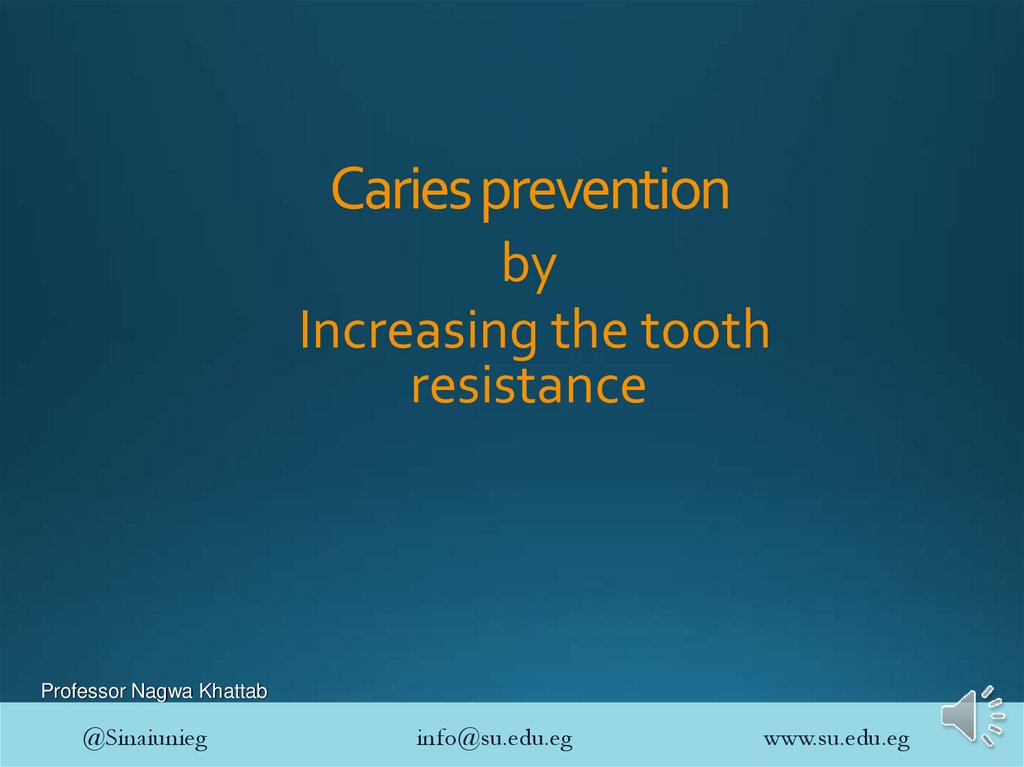
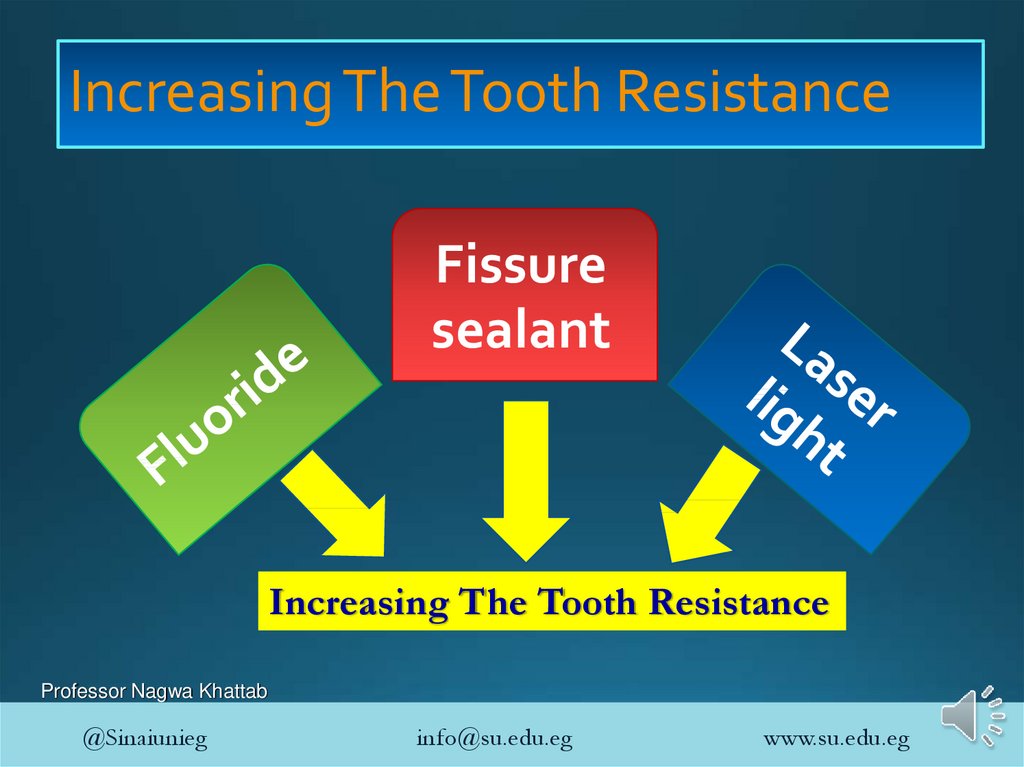



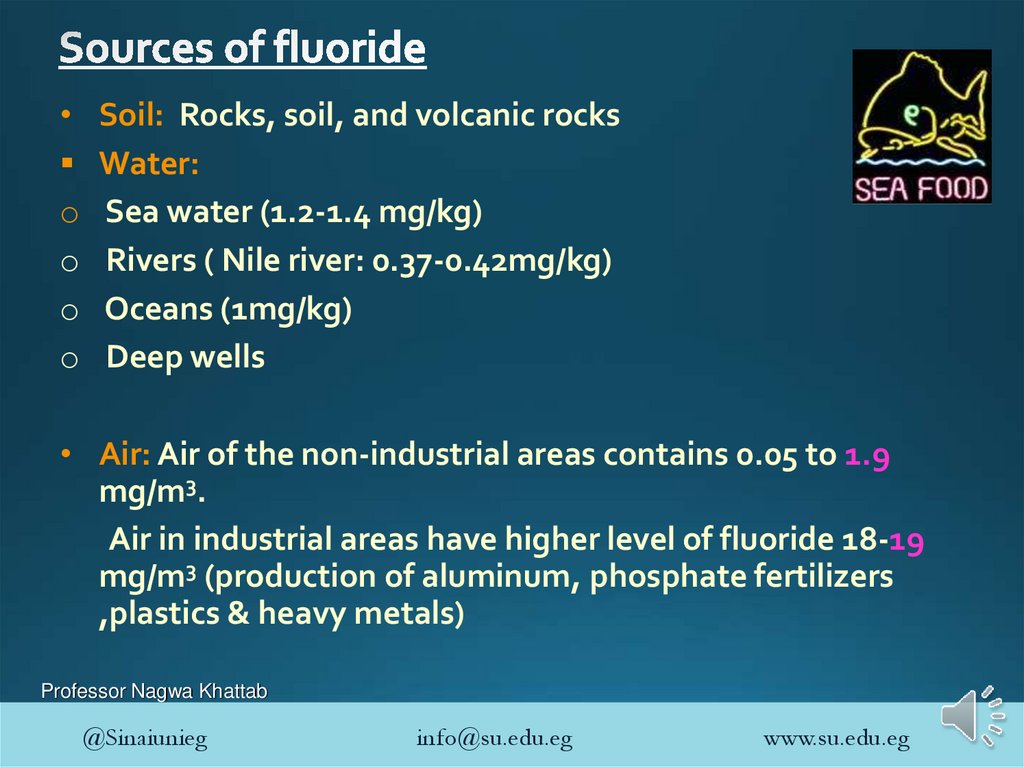
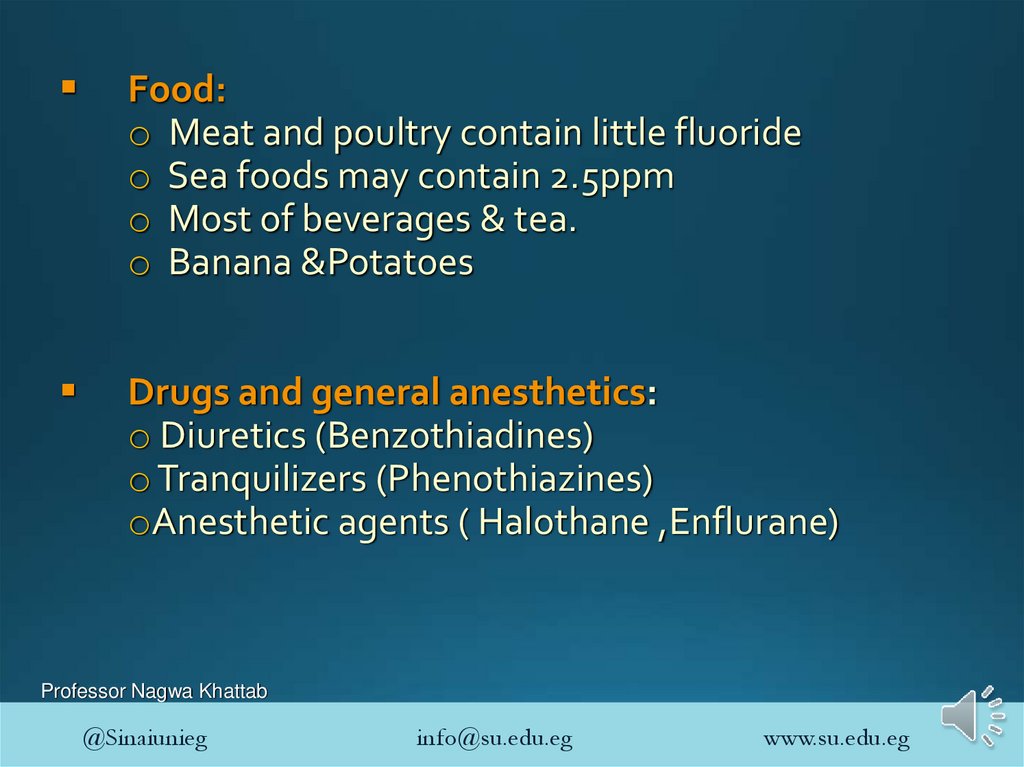


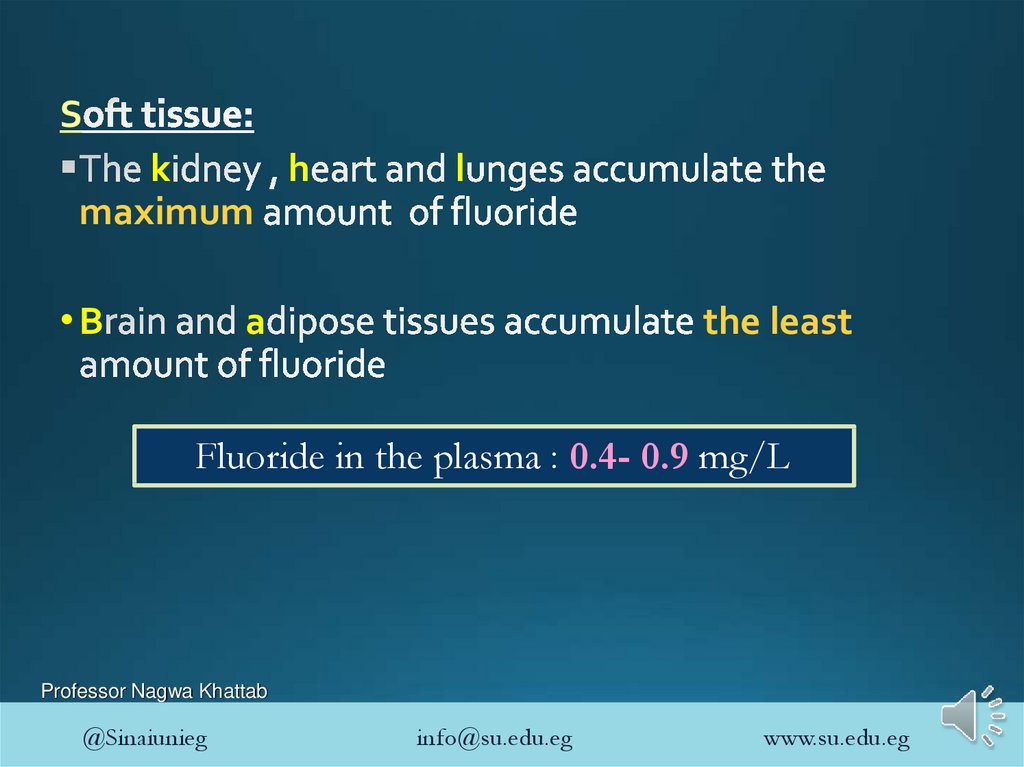

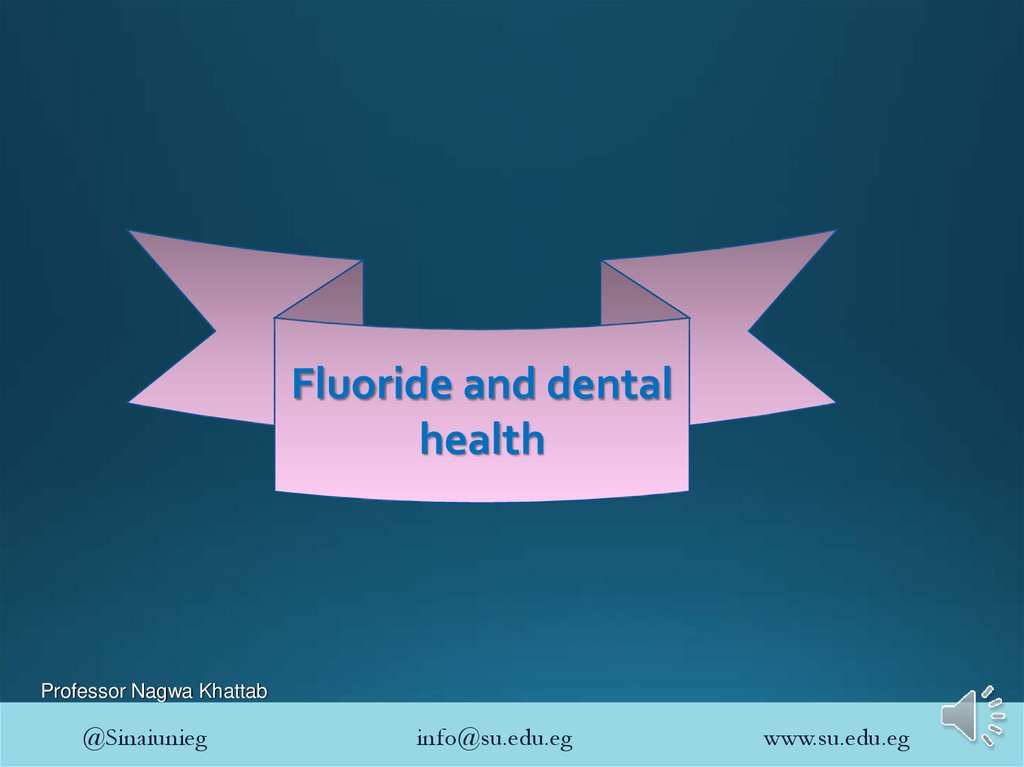

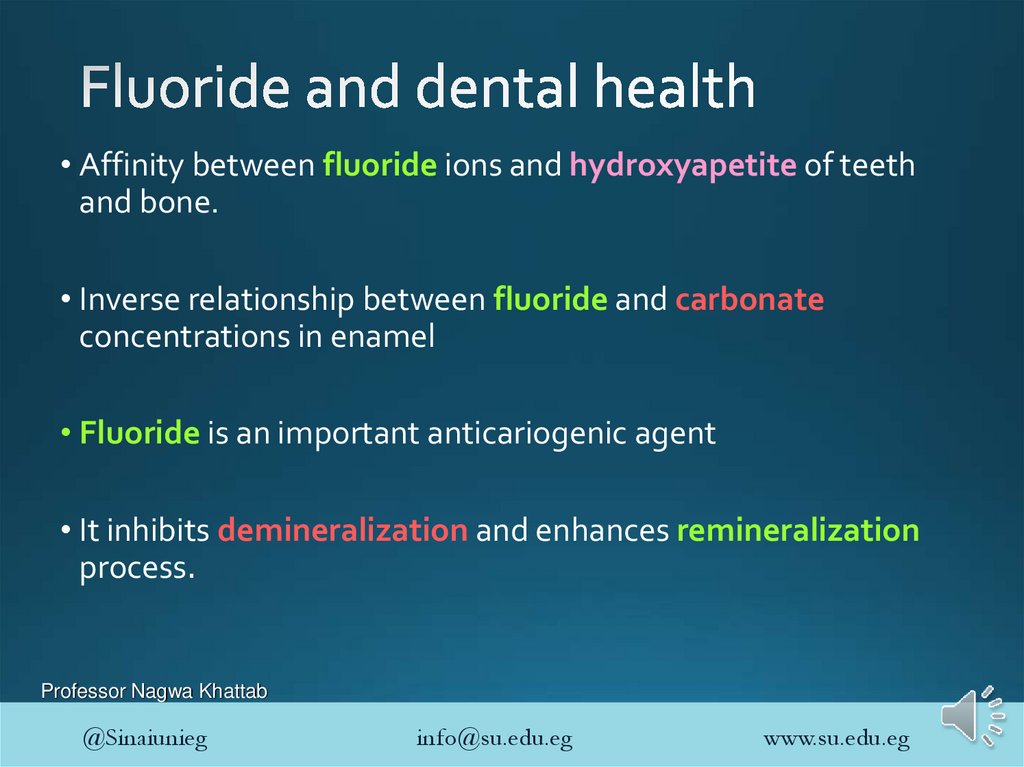










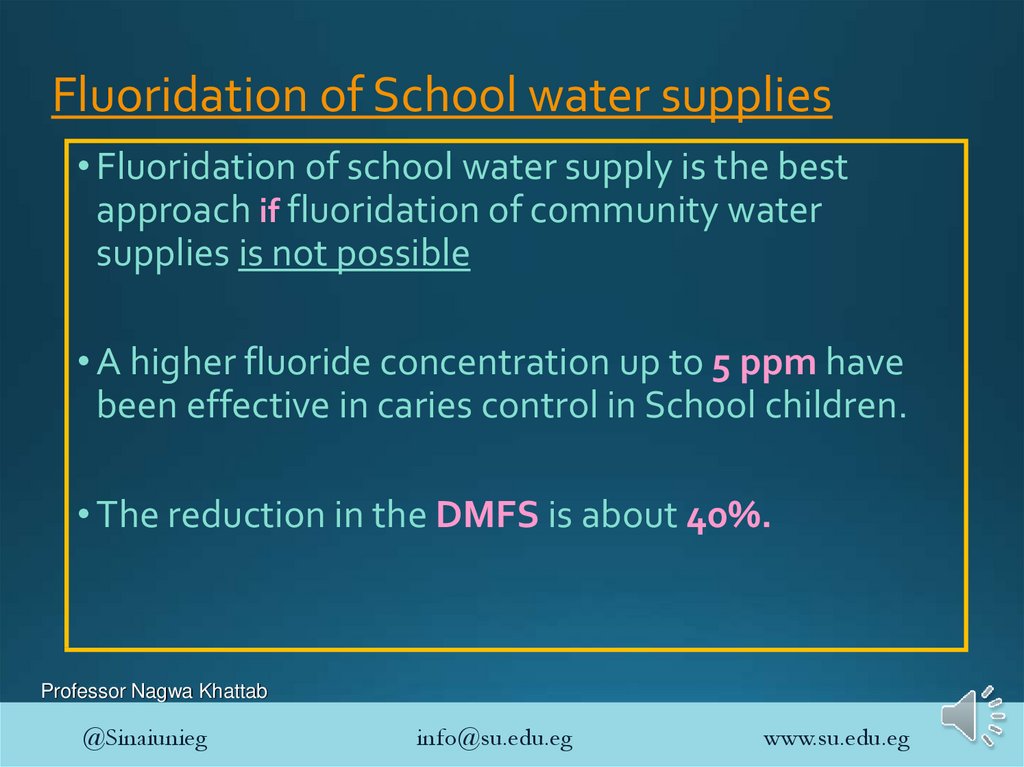





 medicine
medicine








